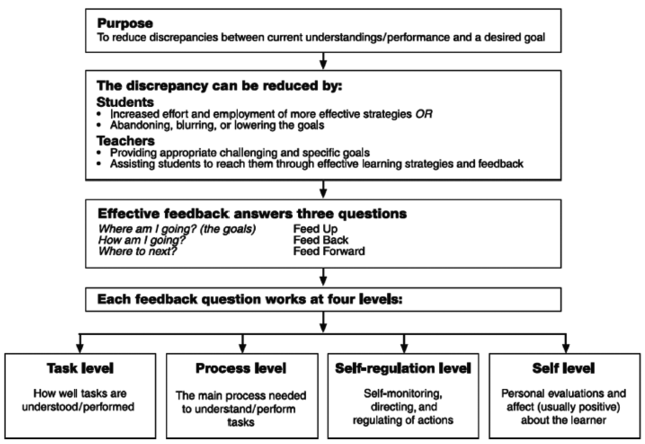Feedback
Please take a few minutes to read Hattie’s book section Feedback in Schools, linked here.
As you read, make note in particular of the three feedback questions,
- Where am I going?,
- How am I going? and,
- Where to next?
and also the four levels of feedback,
- task,
- process,
- self-regulation,
- and self.
The following diagram shows Hattie’s model as a flowchart.

Hattie, J., & Timperley, H. (2007). The power of feedback. Review of Educational Research, 77, 81–112. https://doi.org/10.3102/003465430298487
As a learning designer, you need to consider how you will provide opportunities for feedback. In EDCI 335, we are relying on lots of peer feedback, described below, and also providing ways for you and your learning pod to get more specific and focused feedback as needed. Feedback from multiple sources (instructors, peers, authentic audiences) contributes to the learner developing the necessary metacognitive skills and strategies to take responsibility for their own learning. Feedback should answer each of Hattie’s three questions, it should be directed at reducing the gap between the learner’s performance and the learning outcome, and it should provide a clear pathway to improving performance.
Peer Feedback
An under-appreciated form of feedback is peer feedback, where a learner’s peers provide feedback based on specific criteria. Slavin (2011) found that, in addition to the social pressure for group members to help each other, there are cognitive benefits to both giving and receiving feedback from peers. For the learner giving feedback, there can be significant benefits from the processes of elaborating on explanations where the learner giving feedback needs to elaborate on their own understanding of the concept in order to explain it more clearly to their peer. Additionally, this models for the receiver how the giver thinks through the concept, giving them exposure to a wider variety of cognitive skills. The receiver also benefits from the provision of simplified explanations that are specific to their own concerns, from the ability to practice, and simply from receiving correction about their work.
Watch Austin’s Butterfly to observe the power of feedback for a Kindergarten learner. Feedback should be timely, specific, and constructive. When feedback is presented in a way that makes the necessary changes appear accessible, within reach, and something that will clearly improve the original product/attempt, it makes it easier to receive and apply. Pay close attention to how each attempt shows such drastic improvement. Try to identify the specific feedback that led to the changes in each of Austin’s attempts. How can you apply what you see in this video to providing feedback to learners or peers?
In EDCI 335, you were asked to form Learning Pods as an initial task. Your projects were designed in a way that asked you to work as a team to create an artifact. Ideally as you worked you collaborated to set informal criteria for what the group work would look like. Your responsibility to your group might be to check in as you work to ensure that your understanding matches what your group is expecting. Negotiating learning experiences together is one way to co-regulate and clarify information during a unit of study.



Leave a Reply